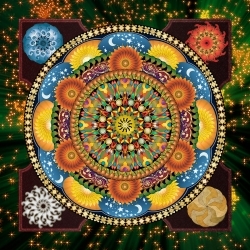Mandala means circle in word Sanskrit. Mandala also has other meanings, such as magic circle or energy concentration, and universally the mandala is the symbol gives integration and of the harmony.
The mandala is a kind of yantra (instrument, means, emblem) which in several languages of the Indostanian peninsula means circle. Strictly speaking, mandalas are ritual geometric diagrams: some of them concretely correspond to a certain divine attribute and others are the manifestation of a certain form of enchantment (mantra).
Its antiquity dates back at least to the 8th century BC. Ç. and they are used as instruments of concentration and to reach higher states of meditation (especially in Tibet and Japanese Buddhism).
For a long time, the mandala was used as an artistic and religious expression, through cave paintings, in the Chinese symbol of the yin and yang, in the Indian yantras, in the thangkas Tibetans, in indigenous healing rituals and art, and in sacred art from several centuries.
At the
Buddhism, the mandala is a type of diagram that symbolizes a sacred mansion, the palace of a deity. Mandalas are usually painted as thangkas and depicted in wood or metal or built with colored sand on a platform. When the mandala is made with sand, right after some ceremonies, the sand is thrown into a river so that the blessings spread.Carl Jung describes mandalas as ideal representative pictures or ideal personifications that are manifest in psychotherapy, interpreting them as personality symbols in the process of individualization.
Many people get mandala tattoos, with different mandalas having different visual patterns that evoke different sensations.
read all about buddhism.
